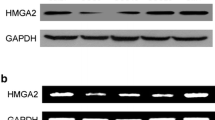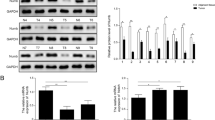Abstract
Four and a half LIM domains 2 (FHL2) is a protein of 279 amino acids in length containing four full LIM-domains and a half LIM-domain at the amino terminus. FHL2 is one transcriptional cofactor that can interact with many different proteins, such as AP-1, BRCA1, IGFBP, and integrin, and involved in organ differentiation, development, cell apoptosis, and carcinogenesis. Recent studies showed that FHL2 could play different roles acting as co-activator or corepressor in different cancer types, depending on the cell types involved. However, no report about FHL2 function in tongue squamous cell carcinoma (TSCC) is available to date. This study aims to determine the FHL2 expression and its biological functions in TSCC via in vitro and in vivo studies. Results show that FHL2 expression was associated with the pathological differentiation of TSCC samples through immunohistochemistry. FHL2 overexpression could stimulate cell proliferation, invasiveness, and metastases investigated by MTT, flow cytometry, Transwell and cell scratch methods. FHL2 could also elevate tumor-related molecule nuclear transcription factor-B (NF-кB) and β-catenin expression levels both at transcriptional and translational levels through real-time PCR and Western blot analyses. The in vivo nude mice experiment showed that the tumorigenicity of FHL2 overexpression group was significantly increased compared with control groups. These results suggest that FHL2 overexpression could contribute to the growth, proliferation, invasiveness, and metastasis of human tongue squamous cell carcinoma; furthermore, its function in TSCC might be related with the upregulation of NF-кB and β-catenin expressions.






Similar content being viewed by others
References
Amann T, Egle Y, Bosserhoff AK, Hellerbrand C (2010) FHL2 suppresses growth and differentiation of the colon cancer cell line HT-29. Oncol Rep 23:1669–1674
Brun J, Dieudonne FX, Marty C, Muller J, Schule R, Patino-Garcia A, Lecanda F, Fromigue O, Marie PJ (2013) FHL2 silencing reduces Wnt signaling and osteosarcoma tumorigenesis in vitro and in vivo. PLoS One 8:e55034
Cao CY, Mok SW, Cheng VW, Tsui SK (2015) The FHL2 regulation in the transcriptional circuitry of human cancers. Gene 572:1–7
Chen YH, Wu ZQ, Zhao YL, Si YL, Guo MZ, Han WD (2012) FHL2 inhibits the Id3-promoted proliferation and invasive growth of human MCF-7 breast cancer cells. Chin Med J (Engl) 125:2329–2333
Duan L, Yao J, Wu X, Fan M (2006) Growth suppression induced by Notch1 activation involves Wnt–β-catenin down-regulation in human tongue carcinoma cells. Biol Cell 98:479–490
Fujii M, Katase N, Lefeuvre M, Gunduz M, Buery RR, Tamamura R, Tsujigiwa H, Nagatsuka H (2011) Dickkopf (Dkk)-3 and β-catenin expressions increased in the transition from normal oral mucosal to oral squamous cell carcinoma. J Mol Histol 42:499–504
Genini MSP, Scholl FA, Remppis A, Mattei MG, Schäfer BW (1997) Subtractive cloning and characterization of DRAL, a novel LIM-domain protein down-regulated in rhabdomyosarcoma. DNA Cell Biol 16:433–442
He KF, Zhang L, Huang CF, Ma SR, Wang YF, Wang WM, Zhao ZL, Liu B, Zhao YF, Zhang WF, Sun ZJ (2014) CD163+ tumor-associated macrophages correlated with poor prognosis and cancer stem cells in oral squamous cell carcinoma. Biomed Res Int 2014:838632
Hu FW, Lee SS, Yang LC, Tsai CH, Wang TH, Chou MY, Yu CC (2015) Knockdown of S100A4 impairs arecoline-induced invasiveness of oral squamous cell carcinomas. Oral Oncol 51:690–697
Huang CF, Yu GT, Wang WM, Liu B, Sun ZJ (2014) Prognostic and predictive values of SPP1, PAI and caveolin-1 in patients with oral squamous cell carcinoma. Int J Clin Exp Pathol 7:6032–6039
Jia LF, Wei SB, Gan YH, Guo Y, Gong K, Mitchelson K, Cheng J, Yu GY (2013) Expression, regulation and roles of MiR-26a and MEG3 in tongue squamous cell carcinoma. Int J Cancer 135:2282–2293
Kleiber K, Strebhardt K, Martin BT (2007) The biological relevance of FHL2 in tumour cells and its role as a putative cancer target. Anticancer Res 27:55–61
Kurakula K, van der Wal E, Geerts D, van Tiel CM, de Vries CJ (2011) FHL2 protein is a novel co-repressor of nuclear receptor Nur77. J Biol Chem 286:44336–44343
Lai CF, Bai S, Uthgenannt BA, Halstead LR, McLoughlin P, Schafer BW, Chu PH, Chen J, Otey CA, Cao X, Cheng SL (2006) Four and half lim protein 2 (FHL2) stimulates osteoblast differentiation. J Bone Miner Res 21:17–28
Lee SH, Koo BS, Kim JM, Huang S, Rho YS, Bae WJ, Kang HJ, Kim YS, Moon JH, Lim YC (2014) Wnt/β-catenin signalling maintains self-renewal and tumourigenicity of head and neck squamous cell carcinoma stem-like cells by activating Oct4. J Pathol 234:99–107
Lim W, Choi H, Kim J, Kim S, Jeon S, Ni K, Song SY, Oh HK, Im Y, Lee G, Lee JY, Moon YL, You JW, Kim O (2014) Expression of cancer stem cell marker during 4-nitroquinoline 1-oxide-induced rat tongue carcinogenesis. J Mol Histol 45:653–663
Martin B, Schneider R, Janetzky S, Waibler Z, Pandur P, Kuhl M, Behrens J, von der Mark K, Starzinski-Powitz A, Wixler V (2002) The LIM-only protein FHL2 interacts with β-catenin and promotes differentiation of mouse myoblasts. J Cell Biol 159:113–122
Mignogna MD, Fedele S, Lo Russo L (2004) The World Cancer Report and the burden of oral cancer. Eur J Cancer Prev 13:139–142
Ng CF, Ng PK, Lui VW, Li J, Chan JY, Fung KP, Ng YK, Lai PB, Tsui SK (2011) FHL2 exhibits anti-proliferative and anti-apoptotic activities in liver cancer cells. Cancer Lett 304:97–106
Qiao L, Wang Y, Pang R, Wang J, Dai Y, Ma J, Gu Q, Li Z, Zhang Y, Zou B, Lan HY, Wong BC (2009) Oncogene functions of FHL2 are independent from NF-κBIα in gastrointestinal cancer. Pathol Oncol Res 15:31–36
Tian X, Wang Q, Wang X (2015) Four and a half LIM domain protein 2 enhances differentiation and mineralization of human dental pulp cells. J Endod 41:513–519
Wang J, Yang Y, Xia HH, Gu Q, Lin MC, Jiang B, Peng Y, Li G, An X, Zhang Y, Zhuang Z, Zhang Z, Kung HF, Wong BC (2007) Suppression of FHL2 expression induces cell differentiation and inhibits gastric and colon carcinogenesis. Gastroenterology 132:1066–1076
Wei Y, Renard CA, Labalette C, Wu Y, Levy L, Neuveut C, Prieur X, Flajolet M, Prigent S, Buendia MA (2003) Identification of the LIM protein FHL2 as a coactivator of β-catenin. J Biol Chem 278:5188–5194
Wu T, Jia J, Xiong X, He H, Bu L, Zhao Z, Huang CF, Zhang WF (2013a) Increased expression of Lin28B associates with poor prognosis in patients with oral squamous cell carcinoma. PLoS One 8:e83869
Wu X, Cao W, Wang X, Zhang J, Lv Z, Qin X, Wu Y, Chen W (2013b) TGM3, a candidate tumor suppressor gene, contributes to human head and neck cancer. Mol Cancer 12:151
Xia J, Wang J, Chen N, Dai Y, Hong Y, Chen X, Cheng B (2011) Expressions of CXCR7/ligands may be involved in oral carcinogenesis. J Mol Histol 42:175–180
Xia T, Levy L, Levillayer F, Jia B, Li G, Neuveut C, Buendia MA, Lan K, Wei Y (2013) The four and a half LIM-only protein 2 (FHL2) activates transforming growth factor β (TGF-β) signaling by regulating ubiquitination of the E3 ligase Arkadia. J Biol Chem 288:1785–1794
Yao J, Duan L, Fan M, Yuan J, Wu X (2007) Overexpression of BLCAP induces S phase arrest and apoptosis independent of p53 and NF-κB in human tongue carcinoma : BLCAP overexpression induces S phase arrest and apoptosis. Mol Cell Biochem 297:81–92
Yu T, Liu K, Wu Y, Fan J, Chen J, Li C, Yang Q, Wang Z (2014) MicroRNA-9 inhibits the proliferation of oral squamous cell carcinoma cells by suppressing expression of CXCR4 via the Wnt/β-catenin signaling pathway. Oncogene 33:5017–5027
Zhang W, Wang J, Zou B, Sardet C, Li J, Lam CS, Ng L, Pang R, Hung IF, Tan VP, Jiang B, Wong BC (2011) Four and a half LIM protein 2 (FHL2) negatively regulates the transcription of E-cadherin through interaction with Snail1. Eur J Cancer 47:121–130
Zhang L, Zhang W, Wang YF, Liu B, Zhang WF, Zhao YF, Kulkarni AB, Sun ZJ (2015) Dual induction of apoptotic and autophagic cell death by targeting survivin in head neck squamous cell carcinoma. Cell Death Dis 6:e1771
Zhu Z, Xu X, Yu Y, Graham M, Prince ME, Carey TE, Sun D (2010) Silencing heat shock protein 27 decreases metastatic behavior of human head and neck squamous cell cancer cells in vitro. Mol Pharm 7:1283–1290
Zienert E, Eke I, Aust D, Cordes N (2015) LIM-only protein FHL2 critically determines survival and radioresistance of pancreatic cancer cells. Cancer Lett 364:17–24
Acknowledgments
Supported by Shandong Natural Science Foundation of China (Grant No. ZR2014HQ075), Medical Health and Development Research Foundation of Shandong Province (Grant No. 2013WS0214) and Science and Technology Development Project of Jinan City (Grant No. 201121042).
Author information
Authors and Affiliations
Corresponding author
Additional information
Qiang Wang and Xiaoying Wang are the co-first authors and have contributed equally to this study.
Rights and permissions
About this article
Cite this article
Wang, Q., Wang, X., Tian, X. et al. Four and a half LIM domains 2 contributes to the development of human tongue squamous cell carcinoma. J Mol Hist 47, 105–116 (2016). https://doi.org/10.1007/s10735-016-9654-7
Received:
Accepted:
Published:
Issue Date:
DOI: https://doi.org/10.1007/s10735-016-9654-7




